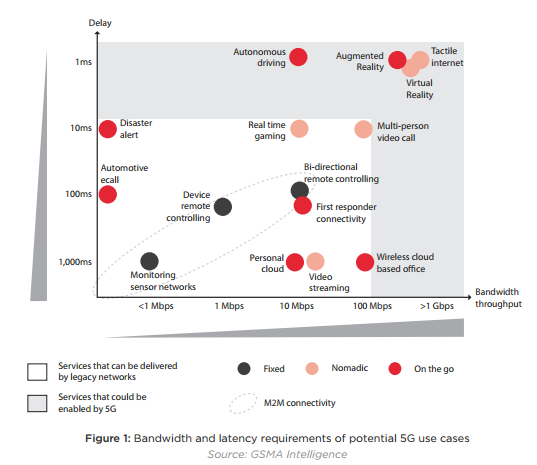New Technologies and their Promise
5G will incorporate a range of new technologies that support new networking models and diverse use cases. This will likely include the use of software-centric network concepts such as network functions virtualization (NFV) and software defined networks (SDN) as well as the use of new spectrum in the mm wave range (>6 GHz) to name a few.
It is important to note that 5G networks will not replace 3G and 4G networks but will be layered on top of them, as well as Wi-Fi networks. Even though 5G introduces new concepts and much higher computing complexity, it is an evolution of 4G, a technology from the cellular community as opposed to an unlicensed technology.
What 5G truly adds over 4G is the option to get even higher data rates (>1Gbps) and lower end-to-end latencies (<1ms). These 2 requirements drive the new radio technologies and new spectrum allocations for 5G.
What is driving the need for such high data rates? Self-driving cars for example will generate 4000 GBytes per day while connected planes will generate 40000 GBytes per day. 5G promises to deliver:
- Data rates of up to 10 Gbit/s per user, e.g. enabling virtual reality (VR) use cases
- Great coverage even in crowded environments such as stadiums or malls
- Full mobility (e.g. for connected cars)
- Highly reliable and responsive, real-time connections (e.g. for traffic safety)
- Connectivity of massive numbers of small low-cost devices that must remain operational for 10 years on a single battery
Key Enablers
Since the use cases and type of connected devices for the 5G era are so diverse, operators will need to select the right enablers that they can choose from to build and customize their range of services. The key enablers include:
- Multiple frequency bands, including unlicensed, with flexible tools, as illustrated here:

- Massive MIMO, beam forming, multiple RAT
- New access methods, including a lean control plane, dynamic RAN, localized traffic flows, device to device (D2D) communications
- Self-organizing networks (SON)
- Heterogeneous networks (HetNets)
- Software defined networking (SDN) and network function virtualization (NFV)
The Challenges Ahead
One key challenge for operators is the reduced latency requirement (<1ms), which will be important for virtual reality (VR) scenarios, real time traffic related control such as V2X, connected and autonomous cars, etc. The laws of physics govern the speeds of signals traveling through air (or light traveling along fiber). Therefore, services requiring a delay time of less than 1ms must have all of their content served from a physical position very close to the user’s device, possibly at the base of every cell and roaming between operators would be questionable for these services. This will require a substantial CAPEX increase spent on infrastructure for content distribution and servers.
Another challenge for operators is spectrum availability for the new 5G network. There is currently a substantial focus on higher frequency radio spectrum, above 6GHz and reportedly as high as 80 GHz, allowing larger bandwidths and thus higher data rates without creating a spectrum turmoil for existing 3G and 4G networks. However, this high frequency spectrum would require an entirely new RAN and be allocated in multiple geographies in the same bands to allow the same radios to be reused across base stations and user devices. Unfortunately, higher frequency bands offer smaller cell radiuses and so achieving widespread coverage using a traditional network topology model would be very difficult. Instead, beam forming must be used, where the beams are directed at the end user device that is being connected to get coverage at greater distances. Beamforming however requires careful tracking of the device location within the cell and cell towers equipped with hundreds of antennae to keep track of the all mobile users traveling through the cell.
To reduce CAPEX and OPEX, operators will rely more on SDN, NFV, SON and HetNets in order to dynamically balance the loads and QoS within their network per user and per service, and also to account for the growing number of IoT devices.
For users that will need handsets or consumer devices with data rates as high as 10 Gbps, and latencies as low as 1ms, modems based on millimeter wave technology will have to be integrated. Voice and other low data rate services will likely continue to use the existing (legacy) networks so these devices will require the integration of an additional modem, RF frontend and antenna array (to support beam forming).
Although 5G networks are often hyped as networks for IoT devices, it is really the IT infrastructure upon which SDN and NFV are built, that will enable massive IoT deployment.
These challenges call for a paradigm shift in terms of the processing power, level of parallelism and flexibility of the compute platform to handle 5G connectivity. Let’s stay tuned and see how the industry will tackle this brave new 5G world.
Learn more
To find out more about CEVA-XC High-Performance, Low-Power DSP Cores for Advanced Wireless Communications.



